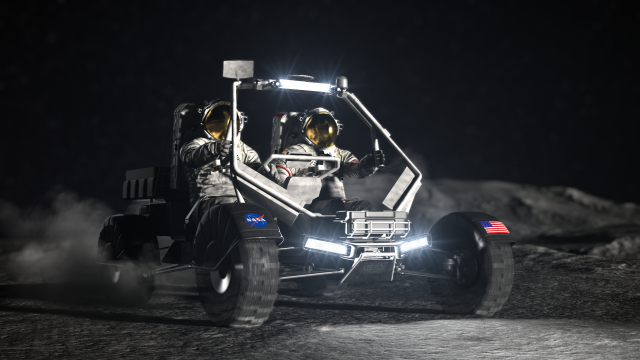A trio of commercial space ventures has been tasked with designing a lunar terrain vehicle for the upcoming Artemis missions to the Moon, helping astronauts explore the south polar region as part of humanity’s return to the dusty satellite.
NASA selected Intuitive Machines, Lunar Outpost, and Venturi Astrolab to develop its Artemis vehicles, awarding the three companies task orders of a combined maximum potential value of $4.6 billion, the space agency announced on Wednesday. The lunar terrain vehicle (LTV) is intended for use during the Artemis 5 mission, which is scheduled for launch in September 2029.
“Think of a hybrid of the Apollo style lunar rover that was driven by our astronauts and an uncrewed mobile science platform,” Vanessa Wyche, director of NASA’s Johnson Space Center in Houston, said during a press briefing. “This will give the crew the capability to travel a distance much farther from their landing sites.”
Apollo astronauts drove around in a battery-powered space buggy, which was manually driven across the surface of the Moon. With its upcoming Artemis design, NASA wants to build a largely autonomous vehicle with robotic, remote operation capabilities that would allow it to explore the Moon on its own, even with no astronauts around.
The Artemis lunar terrain vehicle must also be able to withstand the extreme conditions at the Moon’s south pole, NASA’s target destination for the upcoming missions. The south pole may contain pockets of water ice hidden in the permanently shadowed regions on the Moon, which astronauts could use as a valuable resource to build a future habitat on the lunar surface.
Each of the companies will have a year to come up with the design, and NASA will then issue a subsequent request for the company, or companies, that qualify for round two to continue developing the LTV, as well as come up with a way to deliver it to the surface of the Moon. NASA anticipates selecting one provider for the demonstration.
“We have asked these companies not only to design, develop, and deliver a lunar terrain vehicle, but to also get that vehicle to the Moon,” Lara Kearney, manager of the Extravehicular Activity and Human Surface Mobility Program at NASA Johnson, said during the press briefing. “As part of their proposals, they propose not only the design of the LTV, but also how they launch it.”
That’s a big ask, but at least one of the competing companies has some experience in getting spacecraft to the Moon. Intuitive Machines landed its Odysseus lunar lander on the Moon in February as part of NASA’s Commercial Lunar Payload Services initiative, becoming the first private company to successfully touchdown on the lunar surface.
“I remember about a month ago, I was in this room at a press conference celebrating a successful soft landing on the Moon,” Intuitive Machines CEO Steve Altemus said during the press briefing. “And it’s just an exciting next step to put the first critical piece of infrastructure on the surface of the Moon.”
